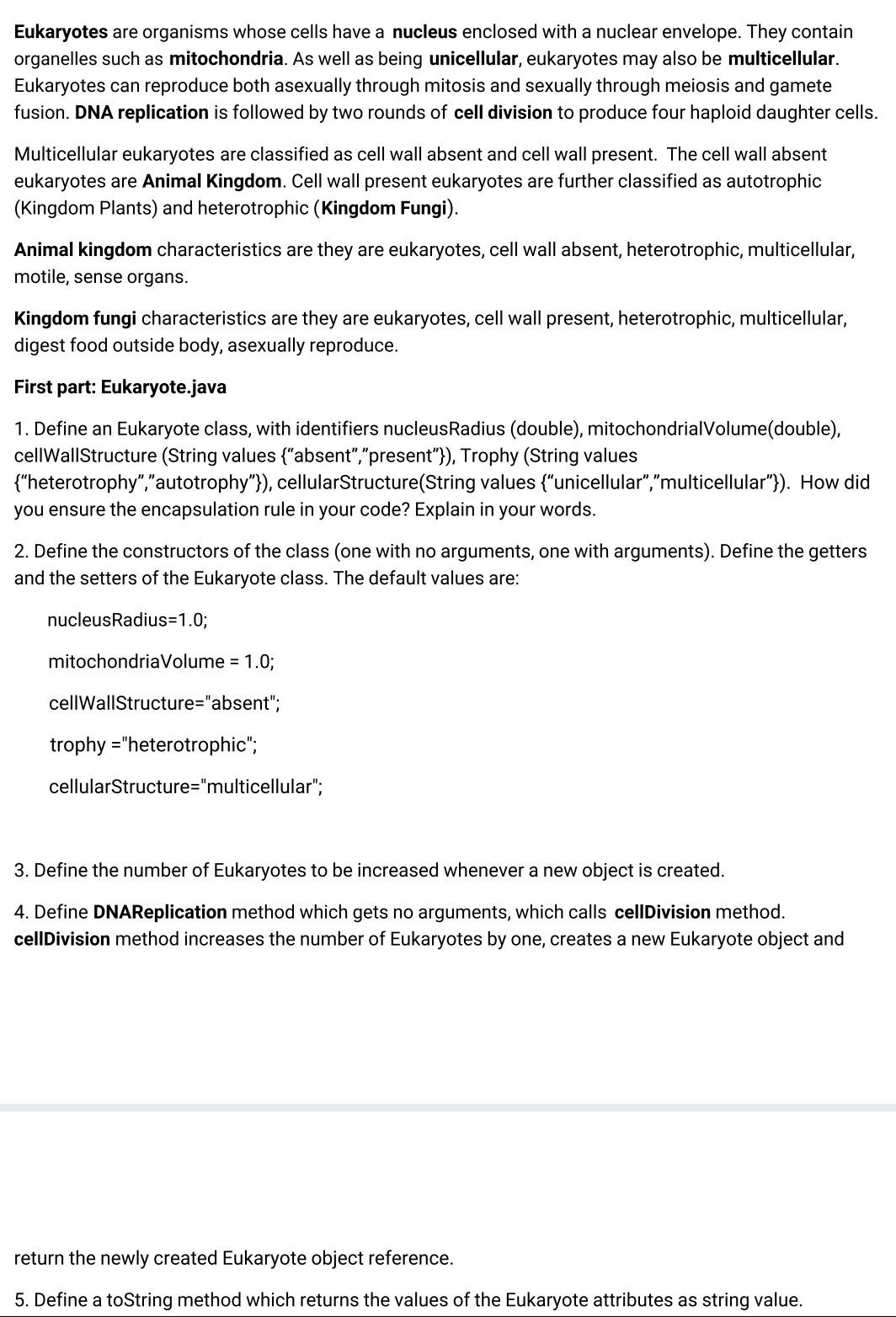Answered step by step
Verified Expert Solution
Question
1 Approved Answer
Eukaryotes are organisms whose cells have a nucleus enclosed with a nuclear envelope. They contain organelles such as mitochondria. As well as being unicellular, eukaryotes


Eukaryotes are organisms whose cells have a nucleus enclosed with a nuclear envelope. They contain organelles such as mitochondria. As well as being unicellular, eukaryotes may also be multicellular. Eukaryotes can reproduce both asexually through mitosis and sexually through meiosis and gamete fusion. DNA replication is followed by two rounds of cell division to produce four haploid daughter cells. Multicellular eukaryotes are classified as cell wall absent and cell wall present. The cell wall absent eukaryotes are Animal Kingdom. Cell wall present eukaryotes are further classified as autotrophic (Kingdom Plants) and heterotrophic (Kingdom Fungi). Animal Kingdom characteristics are they are eukaryotes, cell wall absent, heterotrophic, multicellular, motile, sense organs. Kingdom fungi characteristics are they are eukaryotes, cell wall present, heterotrophic, multicellular, digest food outside body, asexually reproduce. First part: Eukaryote.java 1. Define an Eukaryote class, with identifiers nucleusRadius (double), mitochondrial Volume(double), cellWall Structure (String values ("absent", "present"}), Trophy (String values {"heterotrophy", "autotrophy"}), cellularStructure(String values {"unicellular", "multicellular"}). How did you ensure the encapsulation rule in your code? Explain in your words. 2. Define the constructors of the class (one with no arguments, one with arguments). Define the getters and the setters of the Eukaryote class. The default values are: nucleusRadius=1.0; mitochondria Volume = 1.0; cellWallStructure="absent"; trophy ="heterotrophic"; cellularStructure="multicellular"; 3. Define the number of Eukaryotes to be increased whenever a new object is created. 4. Define DNAReplication method which gets no arguments, which calls cellDivision method. cellDivision method increases the number of Eukaryotes by one, creates a new Eukaryote object and return the newly created Eukaryote object reference. 5. Define a toString method which returns the values of the Eukaryote attributes as string value. Second Part: AnimalKingdom.java 1. Define Animal Kingdom subclass for Eukaryote superclass, with additional identifiers for Animal Kingdom (motility (int), sense Organs(array string[5])) . The subclass follows the rules explained below: Animal kingdom characteristics are cell wall absent, heterotrophic, multicellular, motile, have 5 sense organs. 2. Define the constructors of the subclass (one with no arguments, one with all arguments, using super keyword). Define the getters and the setters of the subclasses. 3. Overwrite the toString method which returns the values of the Animal Kingdom, and Kingdom Fungi as string value. Third Part: KingdomFungi.java 1. Define Kingdom Fungi subclass for Eukaryote superclass, with additional identifiers for Kingdom Fungi (digest (Boolean), reproduction Method(String). The subclass follow the rules explained below: Kingdom fungi characteristics are cell wall present, heterotrophic, multicellular, digest food outside body(true), asexually reproduce. 2. Define the constructors of the subclasses (one with no arguments, one with all arguments, using super keyword). Define the getters and the setters of the subclasses. 3. Overwrite the toString method which returns the values of the Animal Kingdom, and Kingdom Fungi as string value. Fourth Part: TestEukaryote.java Define a TestEukaryote class to create objects (Eukaryote, AnimalKingdom and KingdomFungi). Define a displayEukaryote(Object o) method, which prints the content of the object. The object could be an Animal Kingdom (print motility,senseOrgans), and Eukaryote (print nucleusRadius, mitochondrialVolume). Use instanceOf operator to decide what to print. Call displayEukaryote method with different objects in TestEukaryote. Fifth Part: OOP concepts-UML /class diagram What do encapsulation, inheritance and polymorphism mean? Explain in your terms. Draw the objects and relationships in this project using Class diagram in UML
Step by Step Solution
There are 3 Steps involved in it
Step: 1

Get Instant Access to Expert-Tailored Solutions
See step-by-step solutions with expert insights and AI powered tools for academic success
Step: 2

Step: 3

Ace Your Homework with AI
Get the answers you need in no time with our AI-driven, step-by-step assistance
Get Started


